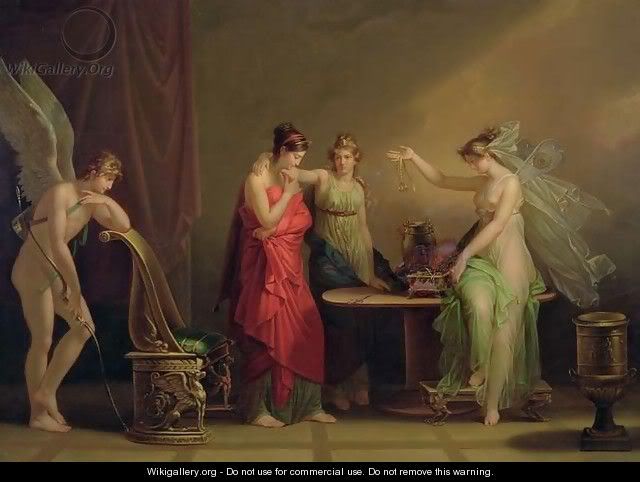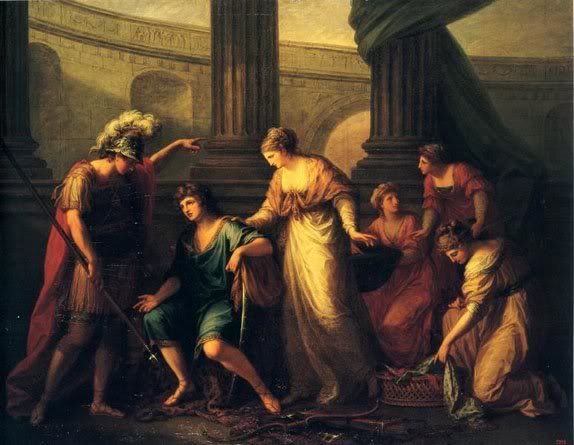She was a neoclassical painter of Swiss origin (born in Chur, Graubuenden, in 1741). At a very young age, she learned the craft of painting from her father, Johann Joseph Kauffmann. The Kauffmanns seem to have moved around quite a lot, and so it was that young Angelica, who showed marked talent already in her twelfth year, came to the attention of the Bishop of Como, the Duke of Modena and the Governor of Milan, respectively, who all requested her to paint their portraits.

Further honing her talents in Parma, Florence, Rome and Venice, in the latter place she made the acquaintance of English noblemen, who persuaded her to take up residence in London. This was in 1766. Notable works she crafted there are "The Mother of the Gracchi", "The Legend of Cupid and Psyche", "The Sacrifice of Messalina" and the "Meeting of Edgar and Elfrida". In 1767 she rather foolishly married a Swiss crook by the name of Brandt who pretended to be Count Frederick de Horn. One year later, after discovering the imposture, a separation followed. The times being what they were, a divorce was not possible. It was not until the impostor died in 1781 that she was able to marry again, this time to Antonio Zucchi, a Venetian painter, who persuaded her to return to Italy. In the intervening years however Kauffmann had made quite a name for herself in Great Britain, to the extent that the Royal Academy of London elected her as one of its original members.

While in Venice, she painted "Leonardo da Vinci dying in the arms of Francis I", then it was off to Naples, and finally the couple established themselves permanently in Rome, where she opened a salon for the arts. There she opened a salon, where notable visitors included Giovanni Bernardo de Rossi, a Christian Hebraist, Jean-Baptiste Seroux d'Agincourt, a French archaeologist and historian, and Johann Wolfgang von Goethe, the famous German playwright, scientist, author, philosopher and statesman, of which she made a portrait.

The Austrian Emperor Joseph II, upon a journey in Italy, became a client also, and for him she crafted "The Return of Arminius victorious over the legions of Varus" and "Æneas celebrating the Funeral Rites of Pallas". Despite her talent and prodigious labor the couple seem to have spent their later years in poverty, and for Angelica this was especially so after the death of her husband in 1795. To an intimate friend she confided that "the poverty does not terrify me, but the loneliness kills me."

Denied, as a woman, to attend drawing courses of nudes, Angelica Kauffmann had forever difficulties with anatomical postures which is why her historical and mythical compositions, inevitably figuring personages in full length, display a certain stiffness. It followed that portrait painting became the craft with which she really made her name. In this genre, the one of the Duchess of Brunswick, George III's sister, is considered her masterpiece. My personal favorite is her portrait of Sir Joshua Reynolds however.

She died November 5th, 1807 in Rome, and was given a splendid funeral. The entire Academy of Saint-Luke followed her to her last resting place in the Sant'Andrea Delle Fratte church, and in the procession, two of her finest works were carried along - just as in Rafael's.

Dead White Female.
MFBB.
No comments:
Post a Comment